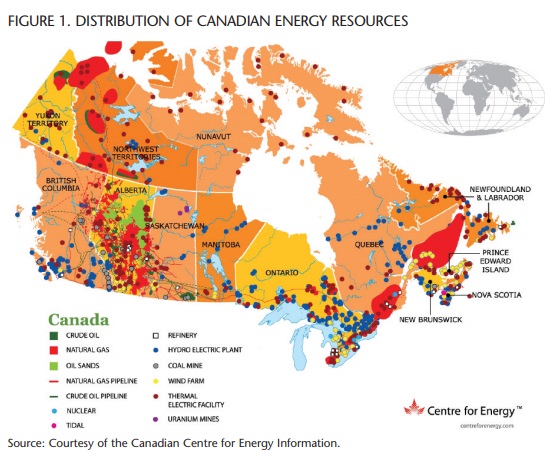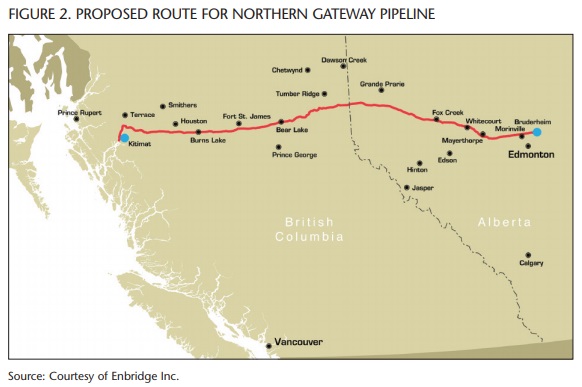
In 1497 the Italian explorer John Cabot was commissioned by King Henry VII of England to find a direct sea route to the Orient. Cabot failed to find the fabled Northwest Passage, as did those who followed him over the next four centuries. But the dream of a “Northern Gateway” to the Pacific never died.
Today, that dream is being realized along Canada’s west coast. British Columbia, with its diverse ethnic population and strong Chinese community, is increasingly seen as a preeminent zone of intersection, connecting the culture and commerce of North America with that of the Asia-Pacific region.
The evolution of the Pacific Gateway is of great strategic importance to Canadians, whose prosperity is fundamentally driven by international commerce. Indeed, we are the most trade-dependent member of the G8 group of countries. With shifting and changing global economic conditions, there is also broad consensus that diversification of Canada’s trade relationships beyond North America is a healthy and desirable objective. The point was driven home by last year’s global recession and slump in US demand for Canadian exports, on top of an established pattern of American protectionist initiatives in recent years.
The age of sailing exploration may be far behind us, but the spirit that drove those entrepreneurial adventurers lives on in Canada’s Pacific Gateway Strategy. Formally known as the Asia-Pacific Gateway and Corridors Initiative, this multi-pronged strategy was launched by the Martin government in 2005. As minister of industry at the time, I recall committing to “tackle the roadblocks that stand between us and a seamless, matchless flow of trade with China, India and other Asian countries.”
The strategic importance of the Asia-Pacific Gateway is underscored by the fact that China’s economy has now taken Japan’s place as the world’s second-largest economy, and is on track to become the largest economy within the next three or four decades.
The roadblocks I was referring to primarily involved freight congestion in BC’s Lower Mainland stemming from the strain on transportation infrastructure — notably roads, rail and port facilities — caused by growth in trade flows along the West Coast. Investments in both the southern (through Vancouver) and northern (through Prince Rupert) gateway corridors have gone far to alleviate these problems.
However, there is another significant infrastructure bottleneck that needs to be addressed. The future development of Canada’s North is closely tied to the region’s resource riches, and that development hinges upon our ability to bring these resources — most notably oil and gas — to market. In this respect, the lack of pipeline and port terminal facilities to safely and efficiently transport western Canada’s resources to energy-hungry customers around the Pacific Rim is critical to Canada’s robust economic future.
At 170 billion barrels, the oil sands of the Athabasca Region in northern Alberta are the second-largest proven reserves of oil in the world after Saudi Arabia’s. Canada is also one of the world’s top producers of natural gas, producing 16.2 billion cubic feet per day.
As figure 1 illustrates, much of this wealth of oil and gas is concentrated in northern Alberta, northern British Columbia the Northwest Territories. With existing pipeline infrastructure, major new markets across the Pacific Rim have very limited access to this energy, including the swiftly growing and energy-hungry economies of China and India; Japan, which has no petroleum reserves; and the West Coast of the United States, where domestic supplies are declining. Indeed, a recently announced US$4.65-billion investment by Chinese multinational Sinopec, in oil sands operator Syncrude — China’s largest ever investment in Canadian energy resources — underscores just how valuable Canada’s reserves are to the economic prospects of people in the developing world.
The strategic importance of the Asia-Pacific Gateway is underscored by the fact that China’s economy has now taken Japan’s place as the world’s second-largest economy, and is on track to become the largest economy within the next three or four decades.
The issue of global access to secure and reliable energy is becoming more acute, and was front and centre at the World Energy Congress in Montreal in September. According to Pierre Gadonneix, Chair of the World Energy Council, “Along with climate change and security of supply, the inequalities in access to energy within and among countries are the three major challenges facing the energy sector.” It is estimated that one and a half billion people today lack access to electricity and modern energy services. In sub-Saharan Africa, more than three-quarters of the population has no electricity.
Global demand for energy is forecast to grow by 35 percent over the next two decades, driven largely by population growth from 6.7 billion today to 8 billion by 2030, increasing migration of people to large urban centres and rising living standards in developing countries.
How will these energy needs be met?
One solution being proposed is Enbridge’s Northern Gateway Pipeline project, which involves building a twin pipeline system running from near Edmonton to a new marine terminal in Kitimat, BC. The system would export petroleum products westward from Canada’s oil sands, and import condensates eastward. (Condensates are light hydrocarbons such as naphtha that are used as feedstock for oil refining and other petrochemical industries in Alberta.) In May of this year, Enbridge filed an application for Northern Gateway with the National Energy Board. If approved, the project could be in service by 2016.
The company’s current pipeline grid carries oil south and east to markets in Canada and the United States. Neither Enbridge nor rival pipeline company TransCanada Corporation has any existing lines to carry oil between Canada’s petroleum industry and the West Coast, although another pipeline operator, Kinder Morgan has a limited capacity to ship oil through Vancouver.
If approved, Enbridge’s Northern Gateway project (shown in the red [solid] line in figure 2) would open up vast reserves of oil and gas — the most affordable, accessible and deliverable energy available today — to generate the power needed by developed and developing countries.
It would also leverage what has been referred to as “Canada’s Pacific advantage.” In the largest sense, this encompasses the strong cultural and economic ties between our country and the Asia-Pacific region fostered through family, business relationships and two-way investment flows. In part this reflects our geographic advantage: our West Coast ports are approximately two days closer to the Far East by ship than other ports in the western hemisphere. That is a crucial supply chain advantage in today’s intensely competitive global markets.
Canada is also well positioned to take a leadership role in supplying the needs of an energy-hungry world. This is not simply a matter of our being blessed with far more oil and gas than we could ever conceivably consume. We can also provide leadership in the responsible development of resources, while setting the bar high in terms of the environment, safety and human rights.
Canadians can be proud of the their energy industry’s overall track record in these areas. Our provincial and federal regulatory regimes and approvals processes are among the world’s most stringent, and no project can move forward without extensive consultations with stakeholders and thorough environmental impact assessments.
Another critical area of leadership emanates from our focus on free and open energy markets. Unfortunately, a major international trend today is away from private capital and free trade and toward managed markets, state control and restrictive rules around foreign investment in energy resource development. Canada has one of the most open economies in the world, and we have had tremendous success in creating well-functioning energy markets, in mobilizing private capital for energy development and in creating an environment conducive to open trade in energy.
Our customers around the world know that they will pay fair prices for Canadian energy resources, based on free market principles. They know that access to Canadian energy will not be subject to arbitrary actions by government, but will be governed by the sanctity of individual contracts and rule of law, including international trade agreements such as NAFTA. And they know that they can participate in Canada’s resource development as owners, joint venture partners or equity investors. In other words, Canada provides an economic and legal framework that gives confidence in sound commercial practices and a secure long-term supply of energy.
This “open for business” approach has been a hallmark of our energy industry and a main driver of its success. Contrast this approach to that taken by Mexico during NAFTA negotiations with Canada and the United States. At that time, Mexico was successful in exempting its oil and gas industry from free trade provisions and from access by foreign investors. Since the ratification of the free trade agreement in 1994, Canada has increased oil production by more than 30 percent and gas production by 25 percent. The industry has earned billions of dollars in foreign exchange, economic and fiscal benefits, and it represents approximately a quarter of the market value of the Toronto Stock Exchange. It employs, directly and indirectly, half a million Canadians and in 2007 paid $24 billion to governments in taxes and royalties.
Mexico’s experience since 1994 has been a stark contrast. It is a growing importer of natural gas, despite vast resources, and is experiencing a steady decline in domestic oil production due to a lack of capital for development.
For Canada to fully assume a leadership role in fostering free energy markets worldwide, we need to diversify our customer base. Today most of Canada’s oil and gas is sold to the United States. Indeed, 99 percent of Canada’s total
exports of energy are to the US. This arrangement has been beneficial to both parties, providing our closest ally and trading partner with a secure and reliable source of energy and bringing significant revenues and investment into Canada. Our shared history and geography, along with our closely integrated economies under NAFTA, will undoubtedly ensure that the US remains our most important customer. But there is no doubt Canada needs to diversify its markets beyond North America. We need to mitigate single customer risks and we need to realize the full value of our resource assets through more competitive pricing.
Projects like Northern Gateway would change this dynamic. By opening up our resources to other countries, Canada would be “walking the talk” on energy access, while at the same time diversifying our customer base and securing the long-term prospects of one of our most vital sectors. We would also be supporting a policy objective we hold in common with the US: the promotion of free energy markets worldwide.
What about impacts closer to home?
Using the Northern Gateway project as an example, we get a sense of the potential benefits for Canadians. According to Enbridge’s estimates, construction of the pipelines and associated facilities, such as the marine terminal at Kitimat, would create 5,500 person-years of onsite employment and an additional 57,200 person-years of employment throughout the Canadian economy. Governments would earn about $85 million per year in tax revenue — dollars that can be invested in research and technology, and that can build schools, hospitals and community centres. Labour income generated by the construction phase of the project would be approximately $2.5 billion in BC, $1.2 billion in Alberta and $4.3 billion for all of Canada. Overall, Canada’s gross domestic product would increase by $270 billion over 30 years.
Pipeline development would also bring badly needed jobs to BC’s North Coast communities — a region that depends heavily on traditional resource industries for employment and that was badly hit by the global drop in demand for resources over the past two years. Some 560 long-term jobs would be created in the area, including 165 jobs in the Kitimat marine terminal and services, as well as tug fleet and environmental monitoring operations.
And it would bring new business opportunities for coastal First Nations, including a proposed joint venture in providing escort and harbour tug services and ownership in the Northern Gateway project.
And this is just one of many projects and initiatives that can underpin a dynamic and powerful foundation for Canada’s future.
But there are risks that must be managed more rigorously than ever before. Given that the proposed pipeline and maritime shipping routes would pass through environmentally sensitive areas, concerns have been rightly expressed about the risk of oil spills. These concerns have been underscored by the unprecedented environmental disaster involving BP’s Deepwater Horizon rig in the Gulf of Mexico and Enbridge’s oil spill near Marshall, Michigan. But the fact remains that Canada’s energy industry operates under environmental stewardship regulations that are among the toughest anywhere.
Can we do better? Absolutely.
There will be valuable lessons learned from these incidents, and emerging technologies will open up new approaches to mitigating risk. But an automatic anti-oil-and-gas response is not the answer. Under virtually any realistic “green energy” scenario the world will continue to need energy from hydrocarbons for decades to come.
As for the safety of oil tanker traffic along the rugged BC coastline, and through the channels leading into ports like Kitimat, Canada’s shipping industry is already one of the world’s safest, and marine protocols for projects of this kind can raise that standard even higher. These include only modern doublehulled tankers to be used; independent BC pilots to guide certified-only tanker crews; all tankers vetted by third-party authorities before gaining entry to West Coast ports; oil-laden tankers tethered to escort tugboats; a state-of-the-art radar system and an automatic identification system to be installed along coastal routes. This world-leading marine safety infrastructure would make the BC coast line a standard for marine safety in the world.
Most Canadians recognize that energy and resources are an essential part of Canada’s economic foundation. This has never proven more true than during the recent global financial crisis. While energy and resource prices fell steeply in the downturn, they also recovered quickly, helping Canada emerge early from the global economic crisis.
The Pacific Gateway Strategy is a linchpin in strengthening and diversifying the Canadian economy by ensuring strong and competitive trade linkages with the world’s fastest-growing economies. Energy pipelines and marine shipping links are an important component. By allowing China, India and other Pacific Rim countries to tap into a vast reserve of secure and reliable energy, we are facilitating their full participation in the global economy. We are building vital new trade relationships for Canada. And we are increasing our power and influence in the international community.
Energy exports to the Pacific will help put BC’s North Coast communities onto a powerful economic trajectory. And they will improve access to electricity and energy for the 1.5 billion people who live today without it, and whose ability to provide for themselves and eliminate the burden of poverty is severely limited. Opening our energy reserves to the world will offer a brighter future for millions of people.
It is time for Canada to take full control of our resources, our markets and our future. It’s time to show leadership in the global energy industry. It’s time to include efficient and safe transportation of energy and natural resources as a vital element of Canada’s Asia-Pacific Gateway and Corridors Initiative. Aspiring masses around the world will benefit, and future generations of Canadians will have opportunities to benefit from Canada’s position in a global economy that is more competitive and dramatically different from anything our generation has experienced.
Photo: Shutterstock









